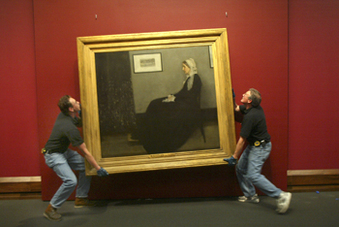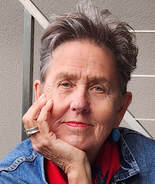The genius and alchemy of opp-shops: the places where the discarded is re-cycled, down-cycled, re-purposed and re-sold and turned into cash which, depending on the opp-shop, supports counselling services, social work, the care of the dying, even the prevention of cruelty to animals.

Mrs Whistler knows all about being discarded and cast-off. When her son James painted her portrait in 1871 he called it simply Arrangement in Grey and Black No.1, a nomenclature which so outraged the English art world that in order to support his family, James had to pawn the painting. Now of course, it is one of the most famous images in the world and is worth millions of dollars.
This is perhaps why Mrs Whistler seems so sanguine about her tarnished frame, the silverfish which are nibbling away at her, and her humble location on the wall of the sorting room of the Salvation Army opp-shop: she knows that given sufficient time and changes in taste, even the apparently worthless discard can garner value.
I am an incorrigible opp-shopper, but even I found myself staggered at quantity and variety of clothing, furniture and bric-a-brac that turned up during the two mornings I volunteered at the Salvation Army’s opp-shop in Vanguard St last week. An opp-shop is in severe danger being sunk by the flood of incoming goods unless it has a full complement of very active volunteers.
What also surprised me is how much must be done to spin the chaff into gold. First comes the triage. Much of the stuff that finds its way into the sorting room is grubby, damaged, missing a vital piece, or is completely and utterly clapped-out. Though some of must be routed to landfill, much of it is salvaged: buttons are cut off worn-out clothing before it is sent off to be made into rags; threadbare human blankets are re-purposed as pet blankets; wonky bookcases, rickety chairs and scooters with loose wheels are repaired; electrical goods are checked for safety; anything which may have extra value - collectibles, vintage items and antiques, jewellery - are put aside for assessment. Every item must then be priced and tagged, hung on racks, stacked on shelves or displayed on tables. Then, and only then, comes the selling. And the buying.
This is the genius and alchemy of opp-shops: they are the places where the thrown away is re-cycled, down-cycled, re-purposed and re-sold and turned into cash which, depending on the opp-shop, supports counselling services, social work, the care of the dying, even the prevention of cruelty to animals.
When I was kid opp-shops smelled to me only of shame and being poor. I dragged my feet whenever my single mother took me there in search of bed sheets or a school uniform to replace the one I had grown out of. I hated the not-quite-right fit of the clothes, the fade marks on the hems of skirts that had been let down too many times. Back then, second-hand meant feeling second best. Much opp-shopping is still driven by economic necessity, but the shops have shed nearly all their shameful connotations and are no longer the province of just the impecunious and the unemployed.
There’s something marvellous about the democratic, sociable, inclusive nature of the opp-shop universe. Everything is affordable. Whether it’s battered or pristine, humble and high-brow, there’s something for nearly every taste and purpose. For nostalgia hounds, creative types and collectors opp-shops are like vast archaeological digs, accessible to all and where the dedicated searcher can unearth all kinds of treasures from bygone eras, made interesting by the patina of age and use.
There’s more than a whiff of melancholy and mortality amongst the profusion: the threadbare teddy bear with the missing eye, the hand-embroidered tablecloth, the carefully executed paint-by-numbers portrait of a swan on a lake. You can’t help but wonder who loved the bear, who laboured over the embroidery and the painting and the route whereby these once-valued things found their way to the opp-shop.
But any is dispelled as soon as you thumb through the pages of the battered blue Warwick 1A5 exercise book in which visitor’s to the Nelson Hospice opp-shop in Bridge St are invited to write.
“I love the gales of laughter that greet us … the staff are actually singing at the moment!” says one delighted customer. ”Always treasures to be found” says another. Every hand-written entry in the book is warm, cheerful and appreciative: “a great service for folks who don’t have a lot”; “It always cheers me up to come into the warmth, light and friendliness”; “I can’t walk by without a peek”; “I love this place. Bless you!”
My favourite comment, and I am sure James Whistler and his mother would agree with the sentiment expressed, declares “You really can never tell what kind of adventure may be possible, starting from where you stand”
 RSS Feed
RSS Feed

